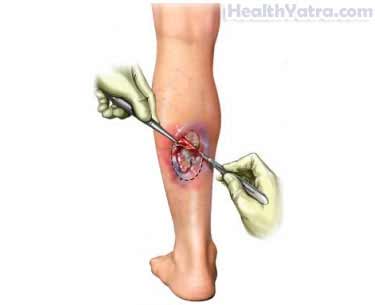Definition
Debridement is the removal of unhealthy tissue from a wound to promote healing. It can be done by surgical, chemical, mechanical, or autolytic (using your body’s own processes) removal of the tissue.

Reasons for Procedure
Debridement is used to clean dead and contaminated material from your wound to aid in healing. The procedure is most often done for the following reasons:
- To remove tissue contaminated by bacteria, foreign tissue, dead cells, or crusting
- To create a neat wound edge to decrease scarring
- To aid in the healing of very severe burns or pressure sores (decubitus ulcers)
- To get a sample of tissue for testing and diagnosis
Possible Complications
Complications are rare, but no procedure is completely free of risk. If you are having a debridement, your doctor will review a list of possible complications, which may include:
- Pain
- Bleeding
- Infection
- Delayed healing
- Removal of healthy tissue with mechanical debridement
Factors that may increase the risk of complications include:
- Infection
- Pre-existing medical conditions
- Smoking
- Diabetes
- Use of steroid or other immunosuppressive medicines
- Poor nutrition
- Poor circulation
- Immune disorders
What to Expect
Prior to Procedure
Your doctor will likely do the following:
- Physical exam
- Take a measurement of the wound
- Provide pain medicine before changing debridement dressings (for nonsurgical procedures)
Arrange for a ride to and from the procedure
If you will be getting general anesthesia, do not eat or drink anything after midnight the night before the procedure
Anesthesia
Anesthesia may be used for deep pressure ulcers or other wounds. Local anesthesia will numb the area. General anesthesia will allow you to sleep through the procedure.
Description of Procedure
The following four methods are often used in combination:
Surgical Debridement
Surgical debridement is done using scalpels, forceps, scissors, and other instruments. It is used if your wound is large, has deep tissue damage, or if your wound is especially painful. It may also be done if debriding your wound is urgent. The skin surrounding the wound will be cleaned and disinfected. The wound will be probed with a metal instrument to determine its depth and locate any foreign matter. The doctor will cut away dead tissue. The wound will be washed out to remove any free tissue. In some cases, transplanted skin may be grafted into place. Sometimes, cutting away the entire contaminated wound may be the most effective treatment.
Chemical Debridement
A debriding medicine will be applied to your wound. The wound will be covered with a dressing. The enzymes in the medicine will dissolve the dead tissue in the wound.
Mechanical Debridement
Mechanical debridement can involve a variety of methods to remove dead or infected tissue. It may include using a whirlpool bath, a syringe and catheter, or wet to dry dressings. Wet to dry dressing starts by applying a wet dressing to your wound. As this dressing dries, it absorbs wound material. The dressing is then remoistened and removed. Some of the tissue comes with it.
Autolytic Debridement
This form of debridement uses dressings that retain wound fluids that assist your body’s natural abilities to clean the wound. This type of dressing is often used to treat pressure sores. This process takes more time than other methods. It will not be used for wounds that are infected or if quick treatment is needed. It is a good treatment if your body cannot tolerate more forceful treatments.
Immediately After Procedure
Samples of the removed tissue may be sent to a lab for examination.
How Long Will It Take?
The length of treatment depends on the type of debridement. Surgical debridement is the quickest method. Nonsurgical debridement may take 2-6 weeks or longer.
How Much Will It Hurt?
During a surgical debridement, general anesthesia prevents pain during the procedure. When local anesthetic or sedative is given, some patients report discomfort. Often, patients will be sore while recovering from the procedure. Pain medicines may be given to help relieve pain.
Mechanical debridement and chemical debridement often cause pain. Pain medicine can be given before changing the dressing to help manage pain.
Average Hospital Stay
Depending on the reason for the debridement, you may be able to go home on the same day. If you are already in the hospital, this procedure should not extend your stay.
Post-procedure Care
At Home
It may take the wound many weeks to heal. A specific wound-care program will be suggested to speed your recovery.
- Follow your doctor’s directions for wound care. If you are unsure about any aspect or unable to manage your care, discuss your concerns with your doctor.
- Keep the wound and dressings clean and dry.
- Ask your doctor about when it is safe to shower, bathe, or soak in water.
- Take medicines as ordered. Do not stop medicines early, even if the wound starts to look better.
Call Your Doctor
After you leave the hospital, contact your doctor if any of the following occur:
- Signs of infection, including fever and chills
- Redness, swelling, increasing pain, excessive bleeding, or discharge at the wound site
- Chalky white, blue, or black appearance to tissue around wound
- If general anesthesia was used—cough, shortness of breath, chest pain, or severe nausea and/or vomiting
- Pain that you cannot control with the medicines you have been given
In case of an emergency, call for medical help right away.
